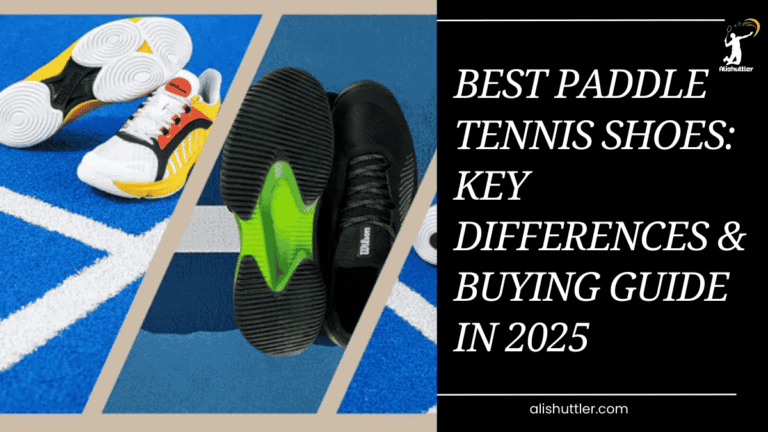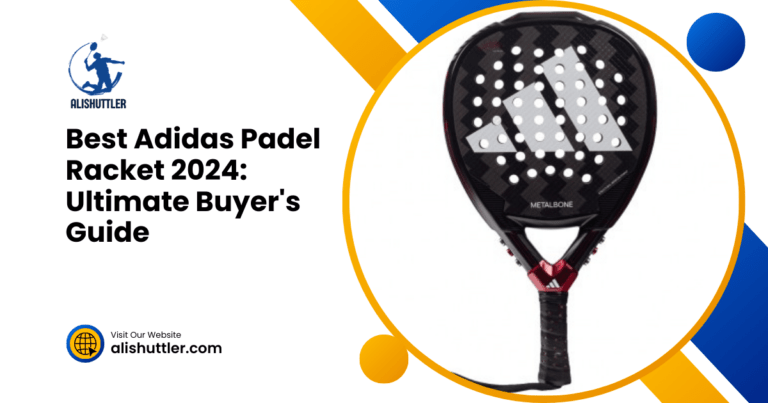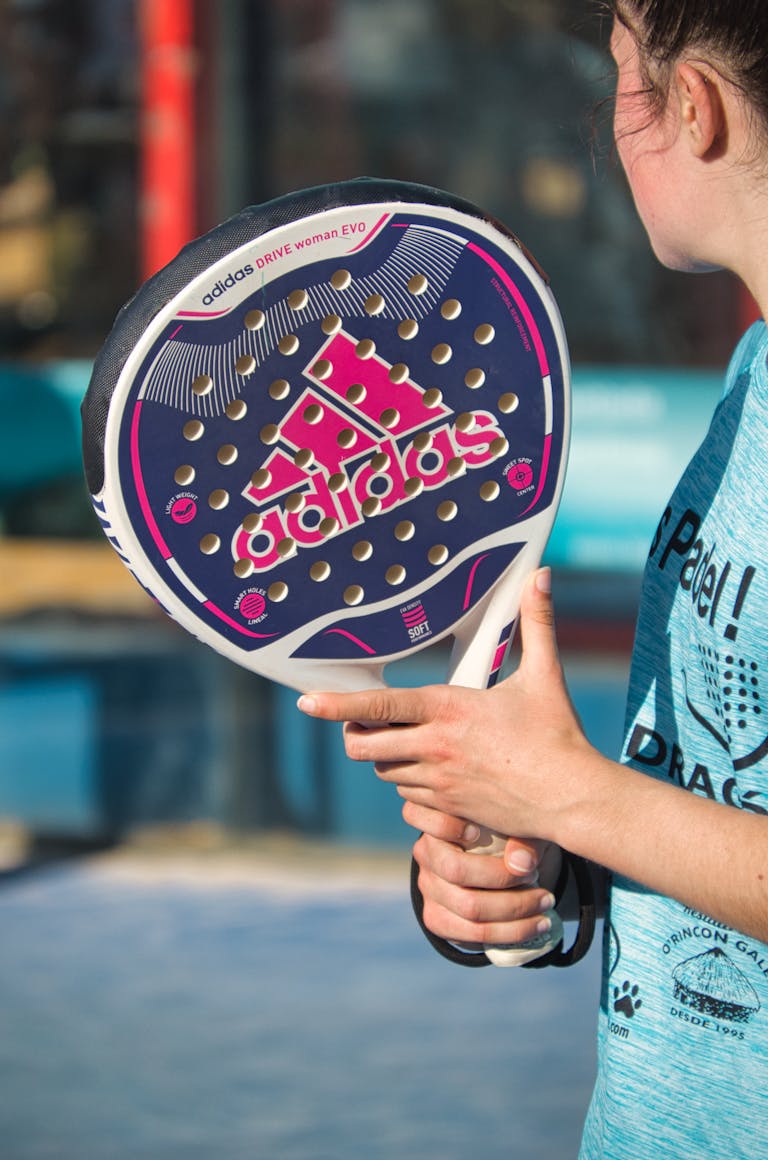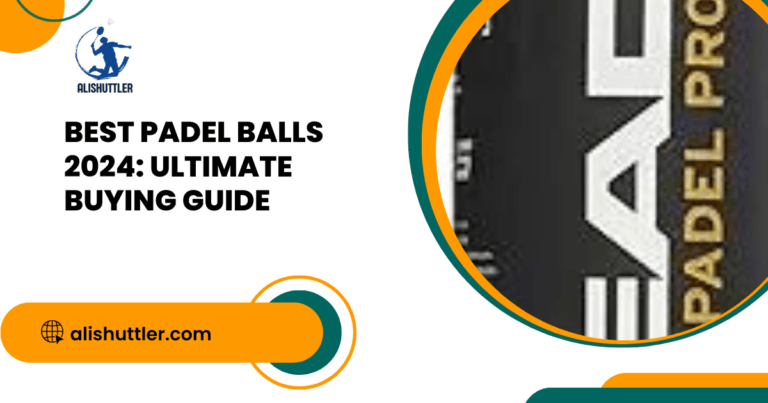The best padel overgrip is one that strikes the perfect balance between tack, sweat control, and 0.5–0.6 mm thickness for feel and shock dampening.
Players consistently rate Wilson Pro, Head Xtreme Soft and Tourna Grip for even tack in heat and powerful moisture wicking. A micro-perf surface enhances airflow and a matte finish assists in drying hands.
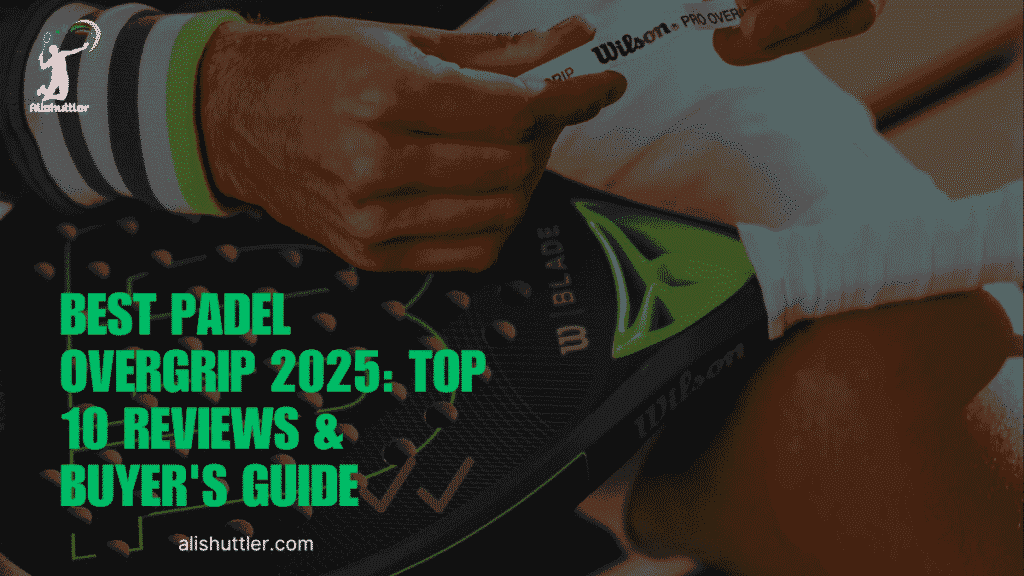
Lighter colors wash out more quickly but remain cooler in the sun. For daily play, replace every 6–8 hours.
Then, essential criteria, test observations, selections.
Overgrip Essentials
Padel overgrips provide a firm, comfortable grip for every level. They prevent the handle from slipping when hands perspire and assist you in guiding the racket with less compression.
Swap them out frequently to maintain feel, hygiene, and control consistent over the course of time.
- Improve grip traction to cut slippage during fast rallies
- Add comfort and soften harsh feedback into the hand
- Fine-tune grip size without changing the base handle
- Manage sweat through absorbent layers or perforations
- Protect the original grip and extend handle life
The Foundation
An overgrip is a thin wrap—usually 0.4–0.8 mm—applied over the stock padel grip or an undergrip, a layer that absorbs abrasion, sweat, and dust so the foundation remains fresh and intact.
It’s standard kit for rookies and old hands because it tunes feel on day one and maintains performance consistent through months.
The majority of overgrips consist of either polyurethane for tack and feel or non-woven microfiber for soft, absorbent contact, while some add perforations to increase breathability in warm or humid conditions.
Compared with a replacement grip, which is thicker and used to replace the original handle wrap, an overgrip is thinner, easier to change mid-season, and ideal for fine, surgical adjustments in tack, thickness, and shock absorption.
You can layer an overgrip over your factory grip, or an undergrip, or even multiple overgrips when you require a bigger handle circumference or additional padding.
A lot of players like the distinct, yet slightly muffled sensation an overgrip provides versus a naked replacement grip, particularly when honing in on touch volleys and lobs.
The Purpose
Overgrips increase control in sweat-drenched conditions—summer sun, indoor humidity, or marathon matches—by enhancing grip and sweat absorption so your racket stays nestled in your fingers, instead of sliding into your palm.
The appropriate surface also helps avoid blisters and reduces hand fatigue, because you don’t have to clench as hard to maintain a grip on the frame.
You can adjust grip size on the fly by wrapping or unwrapping layers without tools.
Match type to style: tacky PU for stop-start control on volleys and bandejas, absorbent microfiber or perforated wraps for heavy sweaters and long back-court rallies, cushioned builds for extra damping if you want less sting on mishits.
Change out an overgrip the moment it appears glazed, becomes slick to the touch, smells funky, or after approximately 8–12 hours of court time.
The Benefit
Key gains are clear: more comfort, tighter control, and cleaner shot aim under pace.
Superior wraps absorb shock and control vibration, which can decrease the strain on the wrist and can potentially mitigate the risk of padel elbow.
A consistent, dry hold develops confidence in critical moments, so you swing unencumbered and aim the ball with more certainty.
| Overgrip type | Primary feel | Best for | Trade-offs |
|---|---|---|---|
| Tacky PU | High stick, crisp touch | Net play, fast volleys | Can get slick with heavy sweat |
| Absorbent/perforated | Dry, secure in moisture | Humid days, long rallies | Less initial stick, needs more frequent changes |
| Cushioned | Softer, muted feedback | Comfort, light damping | Slightly less direct feel of the ball |
The Best Overgrips
Selecting a padel overgrip is ultimately about feel, sweat absorption, and durability, with options like the smooth padel overgrip and grippy gripz available. Players differ: some want a dry handle, while others prefer a tacky grip for better control.
1. For Maximum Tackiness
What sets Get a Grip’s Next Gen Pack apart is its nano-tack coating and 3D honeycomb texture, which locks the palm even through rapid wrist snaps and off-balance smashes. Tacky varieties fit power hitters who require a stranglehold to direct force instead of micro-slips.
Watch tack longevity – other players mention 3-5 matches before stick wears off in sweaty play. Yonex Super Grap and Wilson Pro Overgrip still consistent winners when you need additional tack without a gluey sensation. Textures vary: some lean cotton-like and soft, others feel more rubbery and tack-forward.
Experiment with small 3-packs first, then graduate up to 60-unit cubes if the feel endures.
2. For Supreme Absorption
Wilson Pro Overgrip is a sure bet for sweat-heavy sessions, due to Hydrolast and micro-perforations that pull moisture away from the palm and disperse it through the wrap. Sweat-aiding grips hold the hand dry, reduce slides, and steady shot timing in marathon rallies in hot weather.
Tourna Grip and Dunlop Viper Dry provide viable alternatives if you like a drier, chalky surface – some players even rate their dry grip on par. Some are slick immediately out of the pack and get better within seconds as surface powder hits, while others excel in the wet.
If longevity is a concern, track wear post-shot – results are mixed and a handful of testers recorded just a single session, so extended lifespan is uncertain for some types.
3. For Ultimate Comfort
Babolat Pro Response Overgrip adds a thin memory foam layer that cushions the hand and damps vibration, assisting players with arm fatigue or easing back from elbow or wrist woe. The padding additionally cushions mis-hit impact and can enhance feel on drop shots and close-in volleys.
Beginners and all-rounders like this route as it strikes a nice balance between control and forgiveness without feeling bulky.
4. For Enhanced Durability
Tecnifibre Pro Player employs a Kevlar-reinforced, self-healing polymer skin that defies the abrasion of frequent play. Durability, of course, becomes a factor if you practice a few times per week.
Your grip will stay tack, dry and shapely even after hours. Seek out edges that don’t fray quick, and surfaces that retain their grit under sweat and dirt. Make a shortlist for the lifespan, then compare cost-per-session between 3-packs and 60-packs.
5. For A Dry Feel
Dunlop Viper Dry interweaves ceramic-infused fibers with an antimicrobial finish for a clean, matte hold that doesn’t slick without powder. A dry feel makes sense for players who despise sticky palms, but desire control in the heat or humidity.
Some overgrips have a velvety, fibrous face, others feel cottony. Preferences divide between dry and tacky camps, so try both in dry and wet weather. A solid, dry grip assists in preventing racket twist on big serves and overheads.
Selection Criteria
Fit the overgrip to your hand, court climate and play style. Concentrate on fabric, feel and weight, then verify weather suitability. Grip requirements are individual, so test a couple to find what feels good.
Checklist:
- Material: PU vs microfiber blends; soft vs hard; any additional technology
- Texture: smooth, perforated, or raised patterns for traction and airflow
- Thickness: 0.4–0.8 mm; measure grip size before stacking
- Climate: humid or dry, trade styles by season, and venue
- Feel vs function: tackiness or absorbency (they often trade off)
- Fit: overlap width to tune grip size; experimental wraps
Material
PU rules for tack and clean feel. Non-woven microfiber and synthetic blends drive sweat absorption and comfort. Others blend PU topsheets with absorbent cores to appease both objectives.
Material affects sensation, moisture management and durability. Softer mixes absorb impact and assist touch shots. Firmer films provide crisper feedback and crisper ball notes but can feel abrasive on long days.
For comfort, select softer PU or PU-microfiber blends. For feedback, opt for firmer PU skins. Keep an eye out for hard-wearing additions such as antimicrobial coatings and temperature-reactive layers that remain tacky in the cold or resist melt in the heat.
Texture
Surface design changes control more than most think. Smooth wraps tend to slide a bit in the hand and suit players who regrip mid-swing. Perforated skins vent sweat and accelerate dry time, helpful in steamy courts.
Ridges or raised textures provide bite and hold onto the bevels, which stabilizes volleys and overheads. Players seeking extra traction should opt for aggressive patterns featuring defined ridges. Perforated sheets increase breath and reduce slip when palms go wet.
Examples players often like: tacky ribbed PU for extra hold, micro-perf absorbent blends for humidity, and fine-dimple PU for subtle grip without bulk.
Thickness
Thicker padel grips can significantly change the handle size and balance in your hand. Most of these overgrips span 0.4–0.8 mm. For players with skinny builds, maintaining the base dimension is key, allowing for weightless fast flicks. On the other hand, thick builds provide a comfortable grip that cushions impact and minimizes sting, but they also increase grip size and can diminish feedback.
Medium thickness is often the right overgrip choice for most padel players. It’s essential to measure your grip and then add layers to match your hand size: a slimmer wrap for junior or lady hands, a standard wrap for men’s, and a thicker or extra overlap for larger hands.
For men’s hands, wearing at least a 50/50 overlap is recommended, while smaller hands should opt for a thinner wrap. Choosing the perfect padel grip is crucial for performance, ensuring that you have the right balance between comfort and control during play.
Climate
Like matching the wrap to weather. When heat or high humidity strikes, turn to absorbent blends with perforations to keep sweat at bay. In dry or cool air, a tacky PU stays put without dehydrating the skin.
Switch type by season. A grip that glows in cold, dry play might collapse in hot, sweaty games. Rotate overgrips more frequently in extreme weather to keep grip consistent.
Keep extra grips in your bag so you can switch out mid-session if conditions change.
Professional Insights
Choosing the right padel overgrip, such as a comfortable grip or a tacky grip, is essential for sweat control, feel, and durability under match pressure. Professionals balance thickness and texture against climate, court pace, and opponent style to remain injury-free.
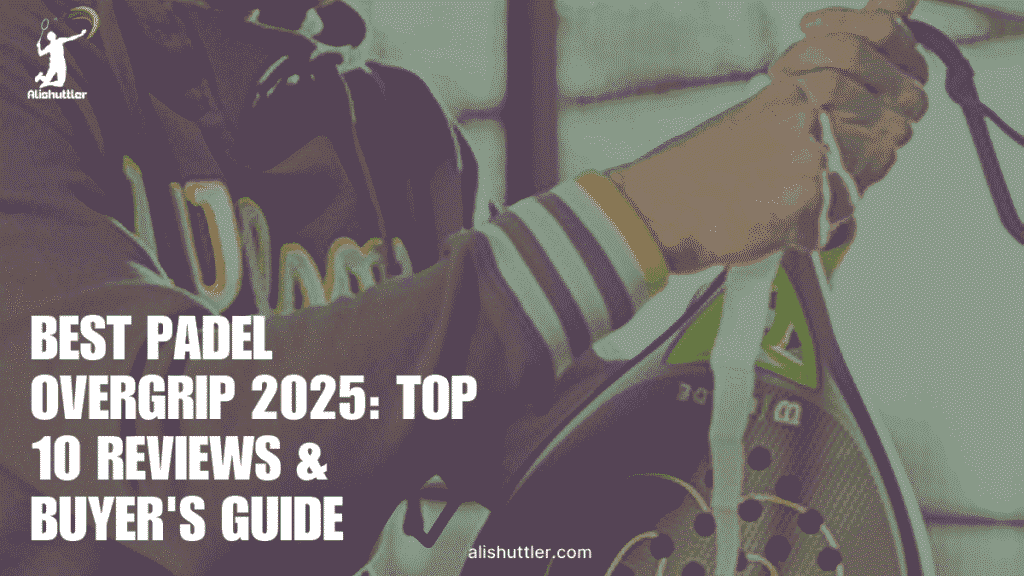
Pro Player Preferences
At humid tournaments, Wilson Pro Overgrip is the standard, as approximately 65% of the pros choose it for consistent moisture absorption and a consistent tackiness. Others switch mid-match to maintain the same friction from first ball to tiebreak, which helps prevent over-squeezing and hand fatigue.
Selection is context-dependent. On quicker surfaces or against power-hitters, aggressive players frequently opt high tack and thinner (0.4–0.6 mm) for bite on volleys. Control-first players prefer medium tack with 0.6–0.8 mm to balance feedback and slip resistance.
Some of our favorite pro-endorsed options are Bullpadel dry feel and control overgrips, Head Prime Tour for consistent tack and Babolat cushioned comfort. Texture matters too: rough for extra grip in sweat, smooth for clean release, cushioned for shock absorption.
Durability varies by style: 6–8 matches for aggressive hitters, 8–10 for control players, 10–12 for comfort seekers. A little table of top players’ overgrips and tack levels will get you somewhere, then you can finesse by climate and your swing speed.
Grip Customization
Layering reshapes seem rapid. One overgrip usually contributes approximately 0.5–1.2 mm to the handle, so doubling up can increase size a half step without replacing the foundation grip.
Coupling a firmer undergrip with a thin, high-tack Best Padel Overgrip complements attacking play. A mid-thickness (0.6–0.8 mm) wrap over a lightly cushioned base bolsters control. A thicker top layer (0.8–1.2 mm) relieves pressure points for those seeking comfort.
Placement changes grip character: tighter spiral and a consistent 3 mm overlap create a firmer, drier face. A slightly looser wrap softens feel and can raise tack. Begin from the butt cap, maintain consistent tension, and end with tight tape to prevent wrinkling.
Color and branding are about more than just appearance; vibrant hues facilitate rapid visual inspections of wear and foster team cohesion. Track tweaks and outcomes: log thickness, tack level (high/medium/low-medium), texture, climate, and errors (e.g., slip on off-center volleys).
Three to five blasts later, your patterns indicate which combo keeps wrist relaxed, contact clean and depth stable.
Best Padel Overgrip Injury Prevention
Handle selection defines wellness. Good tack minimizes the micro-slips that cause blisters and make you squeeze harder, an easy route to padel elbow and wrist strain.
If you suffer from joint pain, opt for cushioned or shock absorbing overgrips with low-medium tack to reduce vibration and grip force. Match thickness to alignment: too thin can over-flex wrists; too thick can change forearm angles.
Most consider 0.6–0.8 mm the happy medium; use 0.4–0.6 mm only if you hold a light pressure, and 0.8–1.2 mm if comfort is your aim.
Change frequently. So casual players can rotate monthly. Regular jocks every 2–4 weeks, earlier in season. Worn, glazed surfaces increase injury hazard by slipping upon impact.
My Personal Take
The selection of the Best Padel Overgrip influences how the racket feels in your hand and affects shot execution. I evaluate each padel grip for a secure feel, both in dry conditions and with sweaty hands.
The Best Padel Overgrip Feel Factor
Tacky Best Padel Overgrips are sticky and provide a secure grip, locking the palm to the handle. They assist on fast volleys but can lag on grip changes. Dry grips feel powdery or velvety, wick sweat immediately, and slide smoothly for resets. Cushioned grips provide a plush buffer that absorbs impact, but may dull feedback.
The right Best Padel Overgrip can transform the connection from hand to racket. I draw cleaner on a dry, fibrous surface, not a slick or glue-like one. I’ll take feel over brand any day. Textures differ so much, velvety, fibrous, cottony, and what sings for one player may feel drab to another.
Test on drills and points, not just warm-up. Ball control on touch shots, Best Padel Overgrip shifts on lobs, and slip hazard when the palm sweats. Some grips continue to be superb when wet, which is ideal for very sweaty hands.
Cost Versus Value
Premium Best Padel Overgrips are more expensive per piece, but they frequently maintain their feel longer and prevent edges from fraying. Budget ones can be awesome for a day, then glaze over or sag, and I’ve had several shed grip after two to three play sessions.
If you play a lot or compete, the superior dry or absorbent models tend to be worth the premium. Durability is important because a consistent surface maintains timing and minimizes mishits late in a session. I measure life in hours on court, and if a grip goes fast, the low sticker price is irrelevant.
For sweat-prone players, absorbent dry grips offer superior long-term value, as they continue to perform even when wet without requiring frequent adjustments. If you play weekly, budget rolls are OK! If you work out 3–5 days a week, opt for the higher levels and replace them on schedule.
| Model (type) | Price per grip (USD) | Typical life (hours) | Cost per hour (USD) |
|---|---|---|---|
| Premium Tacky A | 3.00 | 8 | |
| 0.38 | |||
| Dry Absorbent B | 2.50 | 6 | 0.42 |
| Cushioned Comfort C | 4.00 | 12 | 0.33 |
| Budget Tacky D | 1.20 | 2.5 | 0.48 |
The Unspoken Advantage
A new Best Padel Overgrip elevates attention at critical moments as the hand believes in the grip, and that silent faith liberates the stroke. Small changes, such as shifting from tacky to dry in hot weather, can catch an opponent off guard as your timing and conditioning become sharper.
Repetitive touch hardwires muscle memory, so drops sit shorter and smashes find depth, even late in a long match. I prefer a dry, absorbent surface for clean grip shifts, and I choose based on sweat level: extra-absorbent for very wet hands, slightly tacky for mild sweat, cushioned when I want relief on long sessions.
Some grips degenerate quickly if the edges smooth or the veneer lifts after a handful of matches. I change early rather than tolerate a skid. You should consider the Best Padel Overgrip selection as part of your setup, such as string and balance, and experiment with both dry and wet conditions before committing to one.
Application Guide
A perfect Best Padel Overgrip keeps the racket locked in hand, minimizing slips while maintaining control on all shots in any weather.
Preparation
Rub the handle with a wet cloth, then dry it thoroughly. Sweat and dust cut adhesion, so a clean base keeps slides and premature abrasion away.
Remove the old Best Padel Overgrip and any sticky residue. A little isopropyl alcohol on a rag helps lift glue without damaging the base grip.
Lay out what you need: a fresh Best Padel Overgrip, scissors or a sharp blade, and finishing tape. Keep a small towel handy to keep your hands dry as you work.
Save the handle length and taper. Most padel rackets ship with generic one-size grips, so verify hand fit. As a guide, 1 overgrip with little overlap fits most junior or lady hands, whereas a men’s hand often requires 1 overgrip 50/50 overlapped over the original grip.
A big man’s hand might require two Best Padel Overgrips; adjust the overlap accordingly. Locate the slim tip of the overgrip (frequently labeled with a small sticker). That tip nicks tightly and takes the initial wrap easily.
Wrapping
Begin at the butt cap. Peel off the backing on the skinny, stickered end and secure it so the initial coil juts against the cap lip. Wrap upwards toward the shaft with constant tension, overlapping each turn by approximately 3 mm (1/8 inch).
Maintain the same distance each revolution for consistent thickness and a consistent feel. Match edges so no seams are exposed-this cuts down on hot spots and keeps the twister in the game!
Beware of wrinkles or folds, they dilute traction and numb sensation. If it does, unwrap a few centimeters and flatten it. Adjust the overlap to tune the thickness: a thinner overlap for a slimmer handle, and a wider one for more cushion.
For most men’s hands, a 50/50 overlap over the base Best Padel Overgrip balances girth and shock. For juniors, or a lot of women, use the slimmest overlap you can with coverage. If you have a large hand, lay down a second overgrip, once again maintaining overlap.
Keep a solid, but not hard pull too tight thins the cloth and abridges life; too loose, bubbles. The objective is a clenched, immovable grasp that seems to fuse against sweat.
Best Padel Overgrip Finishing
Above, stitch where the overgrip meets the throat and trim a clean angle so the terminating edge lies flat. Tap the end flat, then coil finishing tape tight for 2–3 revolutions.
Rub the entire grip with your palm, pressing to set the glue and purge air. Look for bulges, gaps, or soft spots that might develop into mid-match slips or blisters. Re-engineer any trouble zone here and now to safeguard safety and performance.
Change your overgrip at the first hint of tack loss, color wear or a surface that feels clammy when dry. A good overgrip should provide dependable traction and firm durability when it ceases to do that, switch it out.
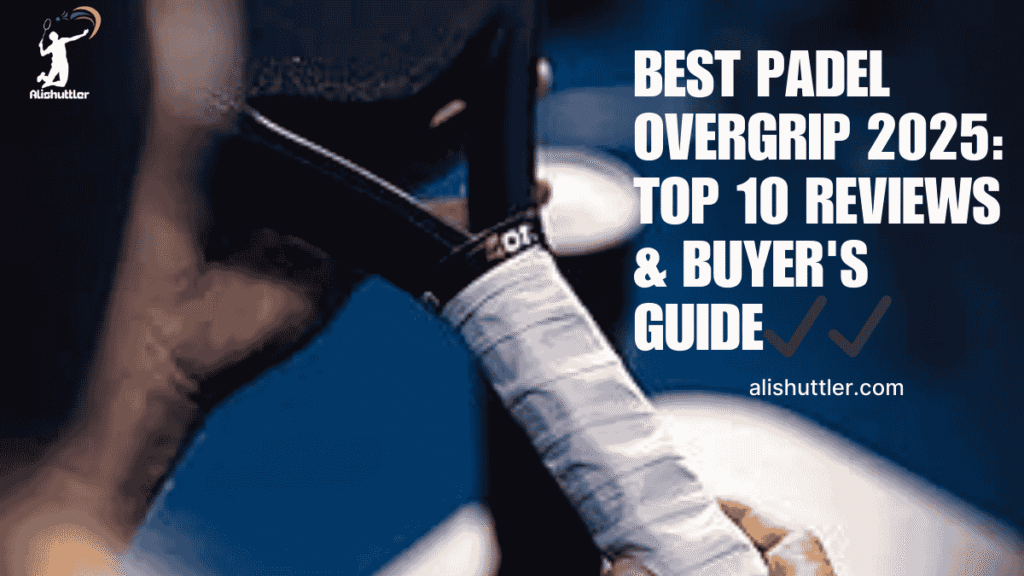
A brief visual guide/video link alongside these steps assists with validating angles, overlap size, and tension on the fly.
Final Thoughts on Best Padel Overgrip
To sum up, tailor the Best Padel Overgrip to your hands, your court, and your sweat. Tacky loves those wet, humid days. Dry feel stands tough in hot, dusty action. Thin tape provides sharp feel. Thick tape provides a small relief on the arm. Switch grips frequently. Every 6 – 8 hours of play does the trick for most of us.
A few small tweaks go a long way. Begin the wrap snug at the butt. Have no wrinkles. Cut off the excess clean. Give a white grip a shot for those crisp wear signals. Go for bold colors if you want quick spot checks in lower lighting. For a moist match, hide two backups in a zipper bag.
Got a favorite selection or an awesome advice? Let me know your drop, or try one new overgrip next game and report back.
Frequently Asked Questions
What is a padel overgrip, and why use it?
A padel overgrip is a thin wrap placed over the base grip, enhancing comfort and sweat control. This grippy gripz covers the handle, adjusts grip size, and limits sweat-related slippage, ultimately preventing blisters for a perfect padel grip.
How do I choose an overgrip for sweaty hands?
Choosing the right overgrip is essential, especially in hot, humid environments where sweaty hands can be an issue. High-tack or dry overgrips, like perforated padel overgrips, provide the perfect padel grip by ensuring quick sweat absorption and stickiness.
How often should I replace a padel overgrip?
Change your padel grip every 6–10 hours of play, or when it starts to feel slippery, slick, or thinning. In hot or humid weather, swap out more frequently. Crazy competitive players often change to a fresh overgrip every match to maintain that perfect padel grip and hygiene!
Tacky vs. dry: which is better for padel?
Both types of padel grips do. Tacky grips, like the popular Wilson overgrip, provide powerful traction and are wonderful to the touch in temperate weather. Conversely, dry grips are better at handling sweaty hands and keeping the playing hand stable in the heat.
What thickness should I choose?
Most padel overgrips range from 0.4 to 0.6mm in thickness. A thinner grip (≈0.4 mm) maintains feel and keeps the grip size smaller, while a thicker one (≈0.6 mm) provides a comfortable grip and adds cushioning.
Can I use tennis overgrips on a padel racket?
Yes, 99% of tennis overgrips fit padel handles, making them a great alternative grip. Choose models with excellent sweat management and uniform tack, avoiding thick replacement grips that can alter your handle size too much.
How do I apply an overgrip correctly?
Begin at the butt cap with your preferred padel grip. Stap the pointy tip down while using 2-3 mm overlap, maintaining constant tension for a comfortable grip. Complete by the throat and tie off with finishing tape, ensuring a reliable feel without wrinkles. Change your overgrip when worn for optimal performance.


